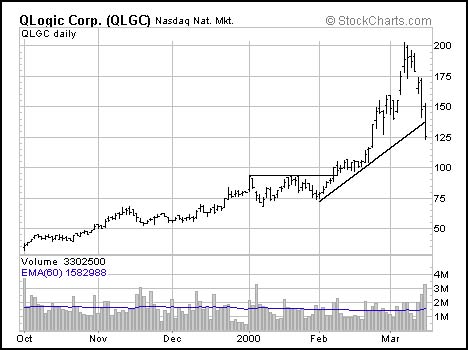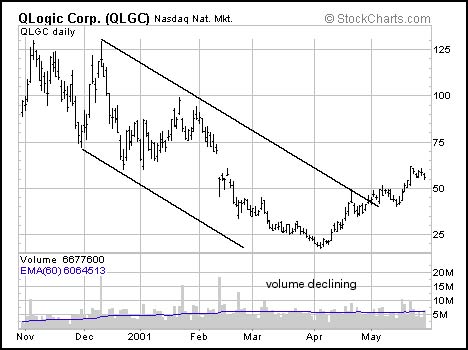|
Volume
should follow the trend. But what happens when a
stock advances and volume contracts -- or a
stock falters and volume expands? It is not
supposed to happen but when it does the result
is almost always a sharp reversal.
Rallies With Contracting Volume
Beware weak volume rallies amid good news
In the winter of 1999 data storage stocks were a
momentum investors' dream. The news flow was
positive and analysts were falling over one
another to make a name for themselves by finding
the next EMC Corp. (EMC). Atop the momentum
mountain was Qlogic (QLGC).

Qlogic had been mired in a consolidation pattern
through early January and February 2000 before
the stock had a volume breakout at $92. From
that point the stock began a parabolic advance
that saw the issue more than double in price in
just one month! It was a momentum investors'
dream come true -- there was just one problem,
as the stock rallied to one new high after
another amid buy recommendations and better than
expected earnings reports, volume was slowing.
In fact, all through the rally, volume did not
approach the high made in early January when the
initial consolidation began. When stocks rally
to new highs amid slow or progressively weak
volume technicians argue that they enter the
distribution phase -- the phase where the "smart
money" begins selling profitable long positions
amid continued good news. By April 15, just
another month later, the stock had fallen from
better than $200 per share to just $60. The weak
volume rally laid the foundation for a
spectacular decline.
Declines With
Expanding Volume
Be careful about selling into weak volume
declines amid bad news
Now let's jump ahead one year. We are still
looking at Qlogic but in the late winter of 2000
the data storage concern was a very different
stock. Ravaged by an ongoing bear market for
technology stocks and a steady stream of
earnings warnings, Qlogic shares had fallen from
favor with Wall Street analysts. Those that once
forecast fundamental splendor now talked
regularly of impending doom.

In the winter of 2000 Qlogic had fallen far from favor
but the stock did begin the process of
consolidating its losses during January 2001 and
early February. The stock rallied from $60 to
$98 during this time frame on better than
average volume only to falter once again in the
middle of February after an earnings warning
from EMC Corp. (EMC). Qlogic, and most other
data storage issues collapsed and by early April
the stock had fallen to less than $20. It was a
short sellers' dream -- there was just one
problem, volume had contracted at each stage of
the march to new lows. When stocks decline to
new lows amid slow or progressively weak volume
technicians argue that they enter the
accumulation phase -- the phase where the smart
money begins adding new positions for longer
term gains. During the span of the next six
weeks Qlogic shares had more than tripled on
increased volume. |